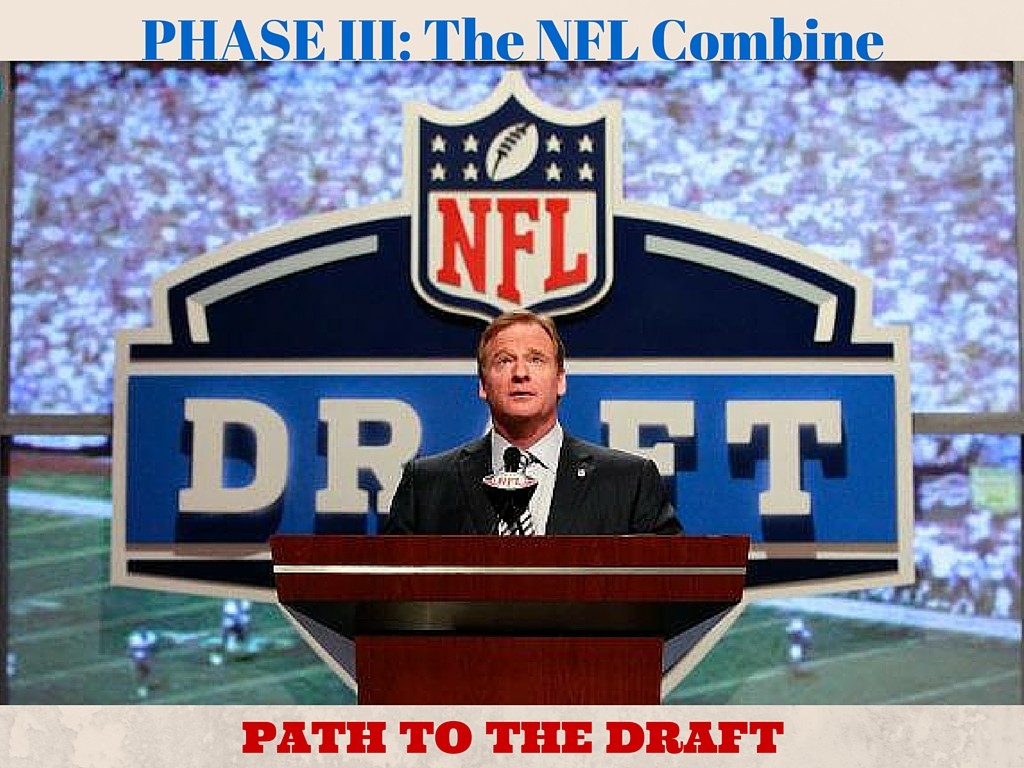Road to the Draft: Phase III The Combine

It’s finally here.
It’s the thought that permeates the minds of all NFL hopefuls as they travel to Indianapolis for the four day extravaganza known as the NFL Combine. All the little league practices, high school 2-A-Days, and endless hours spent in college facilities have led to the opportunity to show case their skills in front of hundreds of NFL coaches and scouts. The drills and tests are now broadcast live on NFL Network, so every friend and family member can witness the success or failure of their every move.
Every 40 step will be analyzed and every dropped pass will be scrutinized. It’s officially big boy football. Every player at the combine is aiming to become a professional, which leads to extra layer of criticism. However most of the criticism doesn’t come from the evaluation on the field. Every year there are players who shock the world with how well they test (both for the good and bad), but most of the physical evaluation is already complete prior to the start of the combine. The attention now turns to the physicals and interviews.
The interviews are the most critical part of the combine evaluation. Each team can conduct individual evening interviews with up to 60 players. The interviews last 15 minutes and are typically blocked from 8 PM to 11 PM. Players walk into each room without knowing what to expect. In some rooms there are scouts and coaches, in other rooms the owner and GM are present. Occasionally players look up and see a psychiatrist in the back to judge the player’s movements and body language. Almost every team will video the whole interaction to review it later, but outside of recording the session, tactics vary wildly.
I interviewed with 24 of the 32 teams, so nearly the entire evening every night was booked. Some teams ask tactical questions and request players to get up on the white board to diagram formations, plays and particular schemes. They want to know each player knew their responsibility, but also the responsibility of the 10 remaining on the field. Other teams know enough about the player’s game knowledge and instead choose to test their poise and ability to control their emotions. Intrusive questions about family and teammates are asked in an effort to make the player uncomfortable. To see if they will turn on a teammate or snap back after an “over the line” question about their family hits a little to close to home. The questions, offensive as they may be, are extremely important because few people will ever experience a work environment as hostile as a NFL.
The second most important piece of the combine is the medical evaluations. Each team feels compelled to evaluate every player with its own medical professionals. A few teams will share medical information, but it basically boils down to 32 physicals over 4-6 hours. It’s so important an entire day is dedicated to the process. The teams will pull and pry and inspect every single item in the prospect’s injury history. Knee scopes from 8th grade will suddenly come under scrutiny and require an MRI to ease any fears the club may have. There are players who will undoubtedly be subjected to 3-4 MRIs in a single day. With each test last a little over an hour, it eats up an little free time the players may have had and are forced to eat a box lunch at the hospital. To put it quite frankly, it’s a miserable time and no one enjoys it. Afterwards their joints hurt and ache for a few days due to all of the cranking. Any injury “flags” require players to return a month or so later for an injury recheck. Indianapolis a short drive from Columbus, so I didn’t mind returning for my ankle check up, but there are players fly in from across the country for a 15 minute examination that could’ve been done during a visit to team before the draft. But it’s what the process it all about.
Every team wants to make sure they leave no stone unturned regarding prospective draftees. The skills will always be evaluated, but no teams wants to be the one who drafted a guy with a chronic knee injury or the team who passed on a future All Pro because they were scared of a reoccurring ankle problem. It’s an inexact science to say the least and even with analytics permeating every sport in America. It sometimes comes down to an 11 PM man-to-man conversation to see if the player has truly moved on from his troubled past or simple chooses to masquerade as a changed man.
